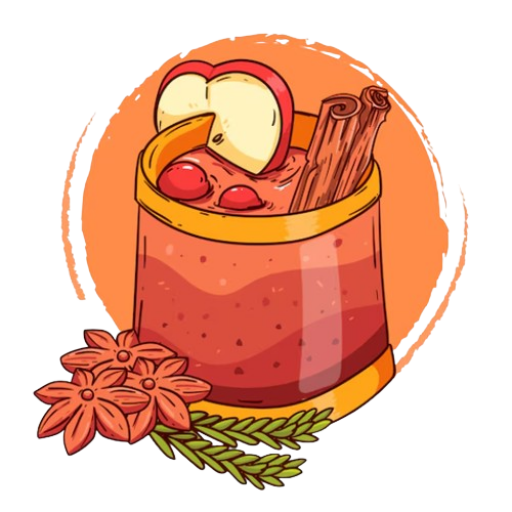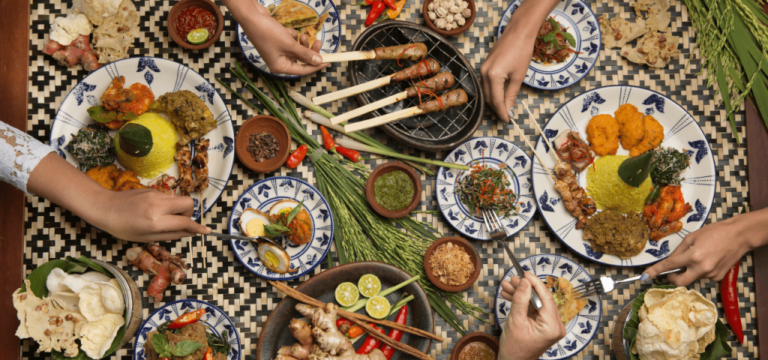11 Traditional Indonesian Dishes You Should Try
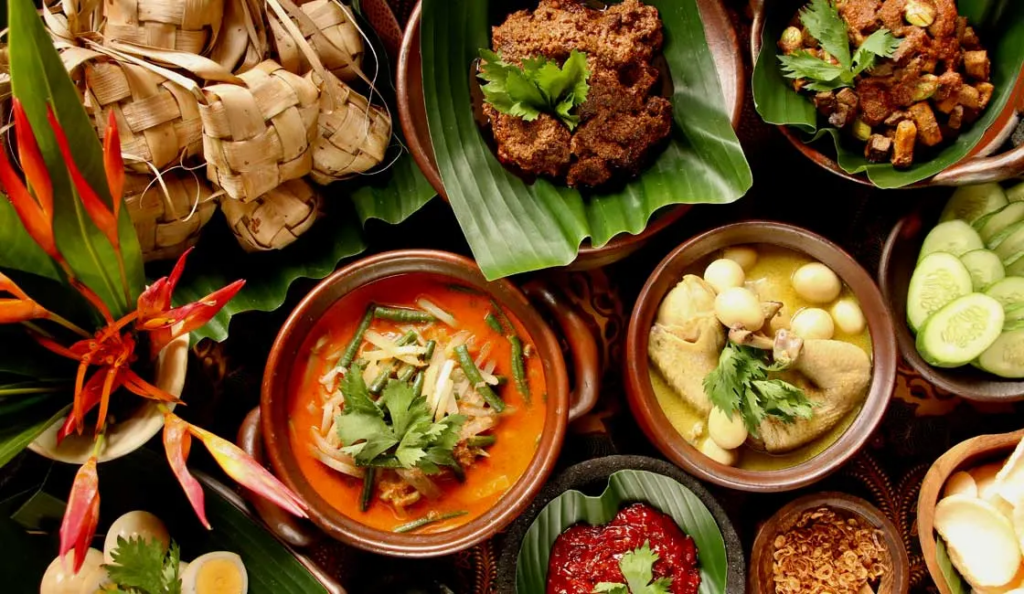
There are 17,000 islands in Indonesia, each with its own distinct flavors and tastes. Indonesian cuisine combines centuries of influences from traders from East Asia, the Middle East, and India with the biodiversity of the region.
Since the islands are naturally different in terms of culture, ethnicity, and flora, Indonesia offers a remarkably varied culinary experience. This article will prepare you for a culinary treasure hunt while traveling by introducing you to some of the most well-known foods in the nation.
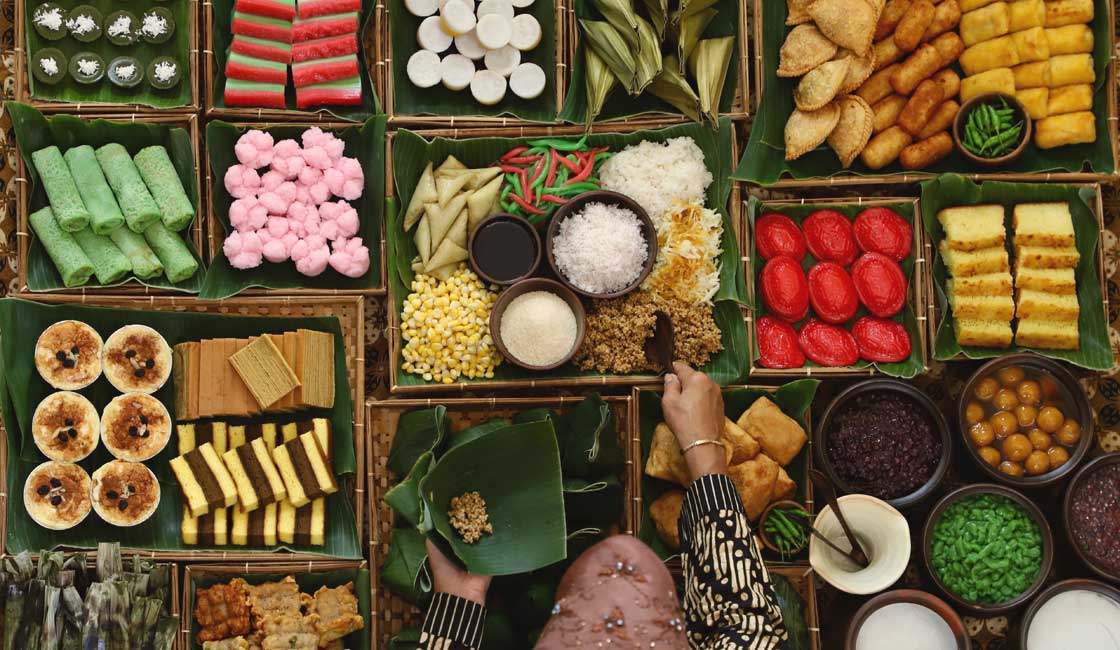
A feast for all senses
A Guide To Indonesian Cuisine
Let’s start with a basic tool to use on your journey – a dictionary. Indonesia speaks 700 languages but the most common and official is Bahasa Indonesia. You will find it on all of the menus you come across.
Here are the most common items you’ll find on every Indonesian menu:
- Nasi – Rice
- Mie – Noodles
- Ayam – Chicken
- Ikan – Fish
- Babi – Pork
- Daging – Meat or Beef
- Sayur – Vegetable
- Keju – Cheese
- Sup – Soup
- Goreng – Fried
- Bakar – Grilled
- Panggang – Roasted
- Sate – Satay
- Spicy – Pedas
Indonesians have unconditional love for rice and it’s the most common staple food across the islands. But as you move east, to Sulawesi, Makassar, Maluku, and Papua you will see taro, sweet potato, or cassava more often. Quite common these days are also instant noodles and even the restaurants have them on the menu.
In the parts of the archipelago where Islam is the strongest – like Sumatra, especially Aceh, pork will never be in use. Bali, the Hindu Island, might be avoiding beef. As you move between islands you will notice all the differences in traditions and eating habits.
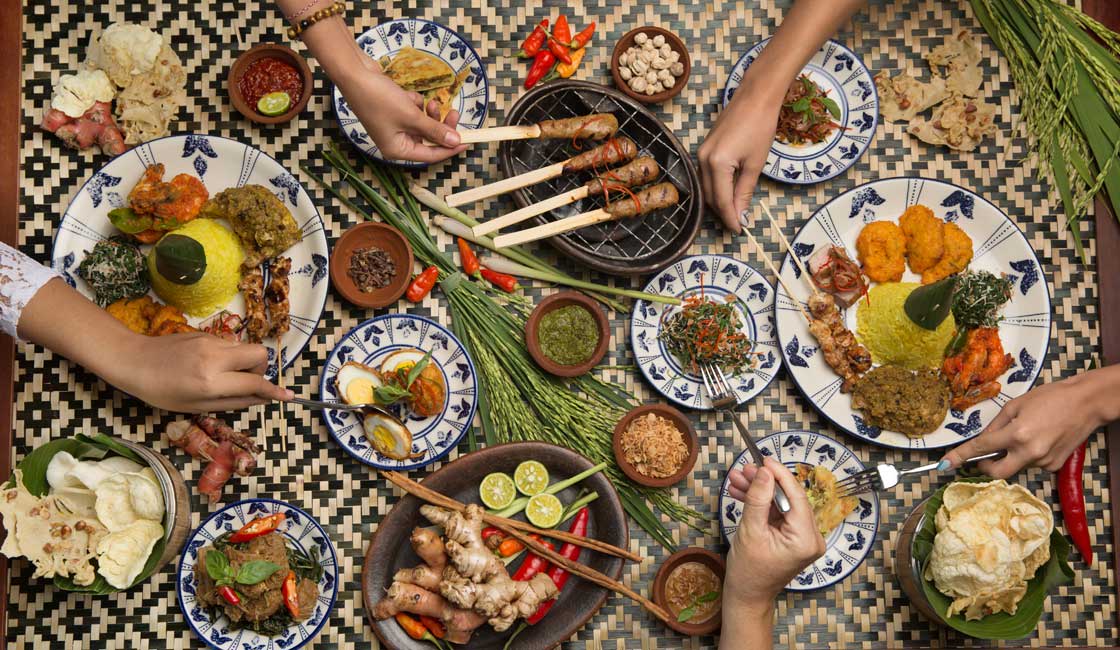
Sharing food is important in Indonesia
Indonesian Dining Etiquette
Meals are served family-style, with big plates and bowls placed in the middle of a table and small bowls for everybody. The meal is initiated by the father or the eldest person at the table and only then everybody helps themselves to portions of food, placing them in their bowls.
Knives are a rarity, a fork and a spoon will be used, but it’s very common to use your right bare hand to eat. For this reason Indonesian dishes many times are served warm, but not hot. If you’re not comfortable eating with your hand, it’s ok to ask for a fork, but the locals will appreciate your willingness to try their way. Remember, use only your right hand and only your fingers – don’t let the food spread all over your palm!

Homemade sambal
The Land of Spices
The treasures of Indonesia have always been spices. The Maluku Islands in particular gained popularity across the world and welcomed traders from as far as the Middle East, India, China, and eventually Europe.
Nutmeg and clove were the most important, but galangal or pandan is also native to Indonesia. Very commonly used are turmeric, coriander, black pepper, shallot, garlic, chili, and tamarind. Ginger, fresh and juicy seems to be present in every Indonesian kitchen and garden. When visiting Spice Islands, you might notice the nutmeg and cloves often spread on the plastic sheets on the road to dry (and advertise to buyers).
Sambal is an important part of Indonesian cuisine and no meal can go without it. It’s a condiment or sauce, prepared from fried garlic, chili, fermented shrimp, and other ingredients, depending on the island. Fresh diced tomato and lime juice are popular ingredients.
Sambal can be spicy or extremely spicy and there are many versions of it. A little jar of Sambal Ulek can be a lovely souvenir from Indonesia!
Bumbu is a seasoning made of (traditionally) stone-ground spices and herbs. The paste can be stir-fried with coconut oil to create an aromatic base for fried dishes.
11 Indonesian Dishes You Must Try
Without further ado, let’s take a look at the most popular national dishes and must-try specialties.

A common way of serving nasi goreng
1. Nasi Goreng
Nasi Goreng is beloved by all Indonesians fried rice.
Sounds simple but isn’t boring at all. Rice has a special place in the hearts of all Indonesians, they respect it and literally can’t live without it. Nasi Goreng is rice with bits of meat (mainly chicken and/or seafood), vegetables, spices, and eggs. There will be shallots, garlic, shrimp paste, some chili, tamarind in most cases. The rice used for nasi goreng is pre-cooked and in many households, the dish is prepared with rice leftovers from the day before.
At the restaurants and street vendors, nasi goreng will be made to order. You can choose what kind of meat (or no meat), the level of spiciness, or how you like your egg added (mixed with the dish or sunny-side-up on top).
Nasi goreng can have multiple versions. Just to give you an idea:
- Nasi goreng ayam – Chicken fried rice
- Nasi goreng ikan asin – Salted fish fried rice
- Nasi goreng cumi – Squid fried rice
- Nasi goreng keju – Cheese fried rice…
The list goes on and on.
The dish will taste differently on various islands and we encourage you to make your own nasi goreng list of discoveries!
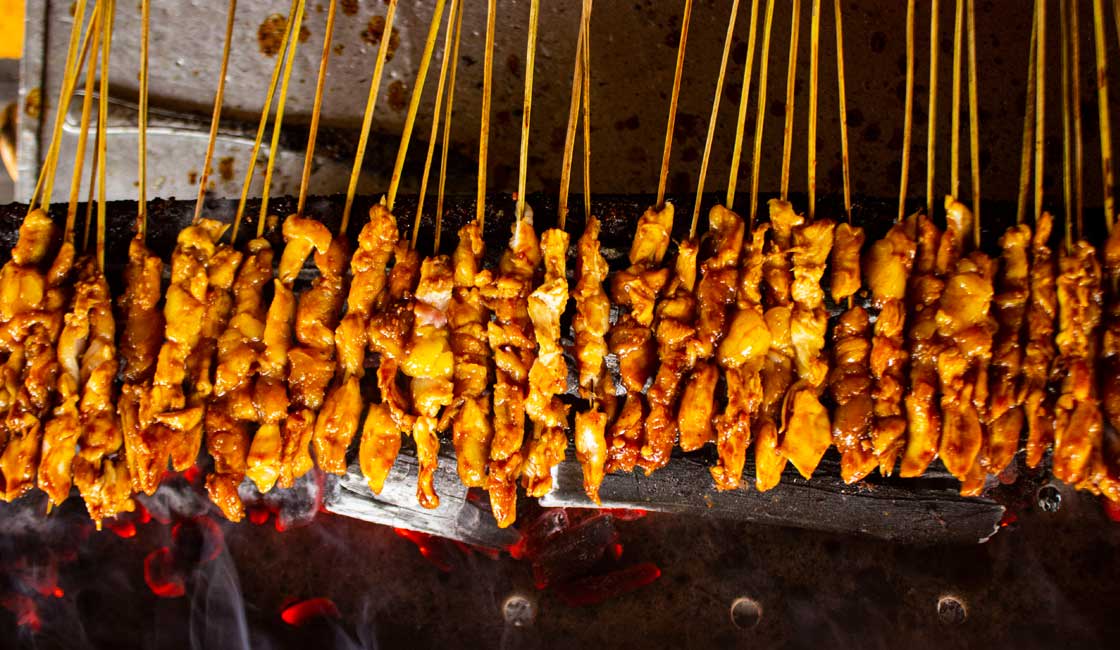
Available every step you take
2. Sate
Satays are popular and present everywhere – street vendors with barbecue stands are found easily, especially if you follow the smell and the smoke. It’s believed that satays originated from Java, inspired by the traders from the Middle East, but now they are popular all across SE Asia.
The meat, diced into small bits, is seasoned or marinated before placing on the grill. You will find all options there: chicken, goat, beef, fish, tofu… Satay will be served with peanut or soy sauce and oftentimes accompanied by the rice cake called ketupat (wrapped in the palm leaf).
When buying from street vendors, simply point which skewers you’d like to have and enjoy them along with the locals. Best not to walk away after buying, as there is a big chance you will want some more.
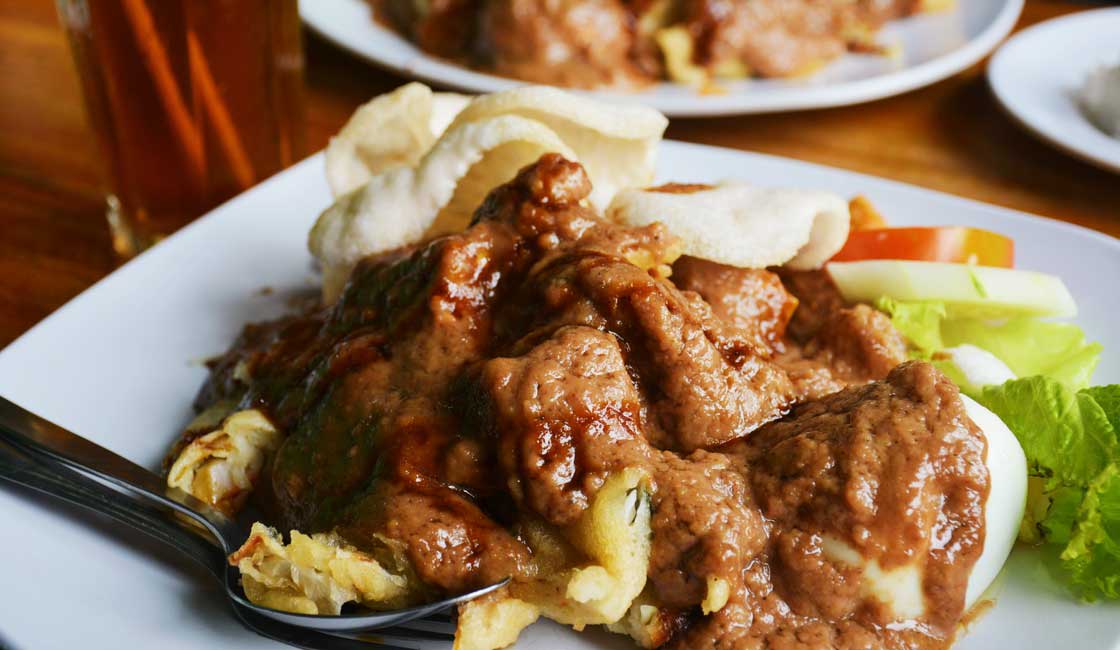
Peanut sauce is the secret ingredient
3. Gado – Gado
A taste of Indonesia you will crave long after your journey. Gado-gado is a salad made of veggies, hard-boiled eggs, tempeh, tofu, potato, and mouth-watering peanut sauce.
You will find some cabbage, spinach, bean sprouts, and jack fruit in it, along with bitter melon, corn, mirliton, cucumber among the vegetables in gado-gado. Traditionally the vegetables are blanched or lightly boiled together and tofu and tempeh are fried separately.
The peanut sauce is the magical touch that makes the salad heavenly good. It’s creamy, but with texture, spicy, but sweet and brings all the ingredients to an exotic and surprising harmony.
Each island has a slightly different version of gado-gado. In Java, you will find a similar dish, called pecel.

Simple and healthy
4. Ikan Bakar
When a country is just many islands, fish must be a popular meal. Literally translated as roasted fish, Ikan Bakar is a simple and beautiful dish for those who like to eat healthily. Do not mistake it for an ordinary grilled fish – this dish has way more to it!
The fish will be marinated in a mix of soy sauce and coconut oil, with a combination of spices. Some of them might be tamarind, shallots, coriander, chili, galangal. The marinated fish is grilled on a charcoal fire. It comes out juicy, fresh, a little sweet, and very aromatic. It is often served with sambal or, in the east, some of the Maluku special condiments like colo-colo, with chili and tomatoes as the main ingredient.

Must try!
5. Pepes Ikan (Daging or others)
Another way of preparing healthy meals in Indonesia is steaming or grilling the meat or vegetables in banana leaf wrapping. This is the meaning of the word “pepes”. Pepes Ikan will have a fish with spices inside, but it can also be anything else – daging for minced beef, ayam for chicken, tahu for tofu, and so on.
There will always be a flavor of the freshly diced shallots, garlic, chillies, coriander, turmeric, ginger, and other spices, blended with your meat or vegetable. Unwrap the leaf and find the perfect meal inside!
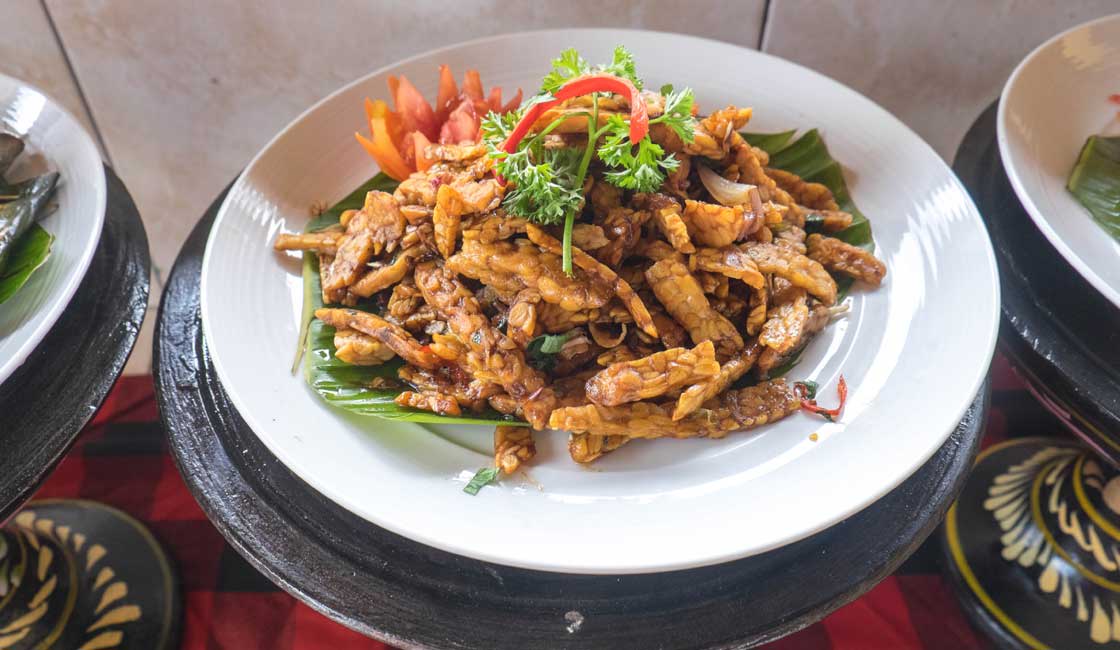
Tempeh is almost a staple Indonesia food
6. Tempeh
Invented by accident, a patty of fermented soybeans is nowadays a worldwide recognized delicacy and a source of protein. Raw tempeh is sold in banana leaf wrappings in any market, especially in Java.
Cuts of fried tempeh are used in salad, rice dishes, and noodles. It can be its own dish, like tempeh goreng – fried, tempeh bacem – braised in palm sugar and coconut water, tumis tempeh – stir-fried with vegetables, tempeh satay, and so on.
Give it a try once in Indonesia, tempeh found in the supermarkets around the world isn’t as tasty as the original one!

Fried chicken like nowhere else
7. Ayam Goreng
Indonesians love their chicken! And for a good reason – the most popular are free-range, small birds with strong, healthy meat, unlike any you find in other countries. An unassuming dish of fried chicken legs can turn out to be a real feast!
The meat is first marinated in the mix of local spices and deep-fried in palm or coconut oil. Juicy on the inside, crispy on the outside! There are many variants of ayam goreng across the islands, keep on trying until you find your favorite!
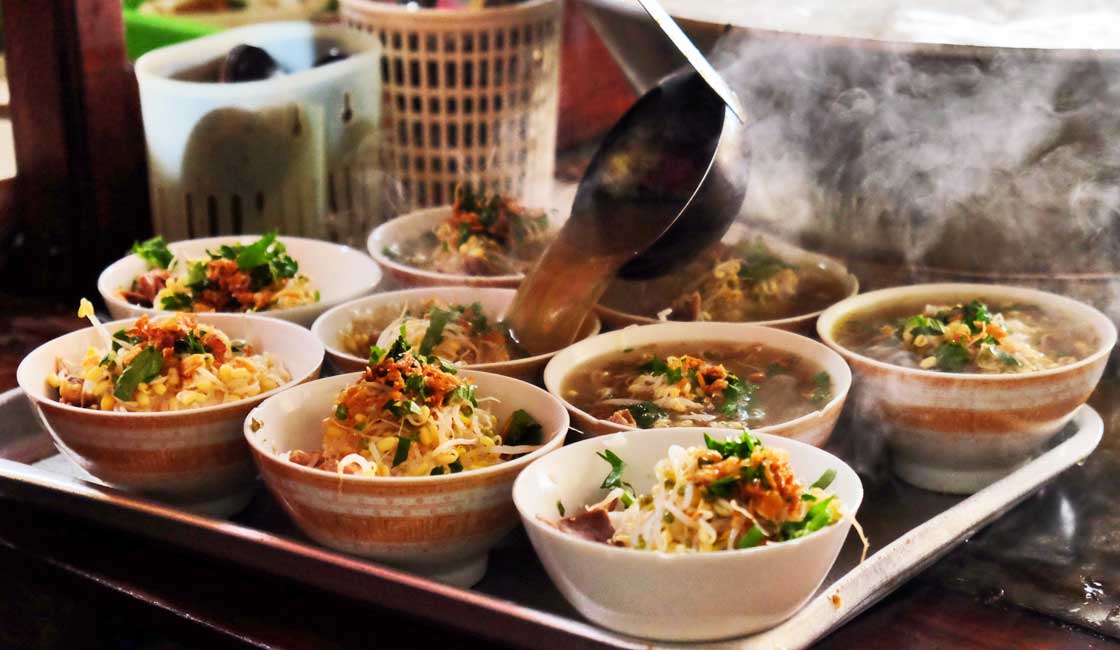
Soto soup street style
8. Soto
Soto is a soup present everywhere but originated in Java. It’s a broth served with bits of meat, boiled eggs, bean sprouts, and other vegetables. Soto Betawi in Jakarta will have meat simmered in coconut milk, and served with steamed rice.
Soto Ayam will be chicken-based, yellow from turmeric, and served with rice cake. Soto Medan has cooked and shredded meat in it, and you can expect boiled eggs, fish cakes, potato fritters, shallots, and other add-ons on top of the bowl.

Always freshly made aromatic bakso
9. Bakso
Bakso is a meatball soup, influenced by European cuisines and similar to the traditional broth. Served with boiled egg and noodles. It’s present across most of the street food stalls as well as the majority of restaurants’ menus.

Veggies and coconut flavors in a bowl
10. Sayur Lodeh
Sayur Lodeh is a soup of various vegetables cooked in coconut milk. Those can be beans, carrots, jackfruit, eggplants, or any other. Rice cake and salted fish or meat will be served with it.

Snack or dessert?
11. Pisang Goreng
If you haven’t had a fried banana, you have not been to Indonesia. Slices of bananas or plantains are deep-fried in cooking oil. It can be battered or plain, coated in breadcrumbs or honey, or made with various other methods.
Bottom line is – pisang goreng is a part of Indonesia like the sea and volcanoes.
Simple, Spicy, Superb Cuisine
The list above only featured three types of sup (soup), but there is such a variety of them across the region, we had a hard time choosing which ones to talk about!
It would be remiss not to mention that in addition to Indonesian cuisine, the country’s coffee is also something to savor, not to mention a great way to start your day, especially with pisang goreng.
Cruising in Indonesia is a lot about diving, turquoise seas, and beautiful beaches, but as you now know, traditional Indonesian food has so much to offer visitors to this flavorful archipelago.
